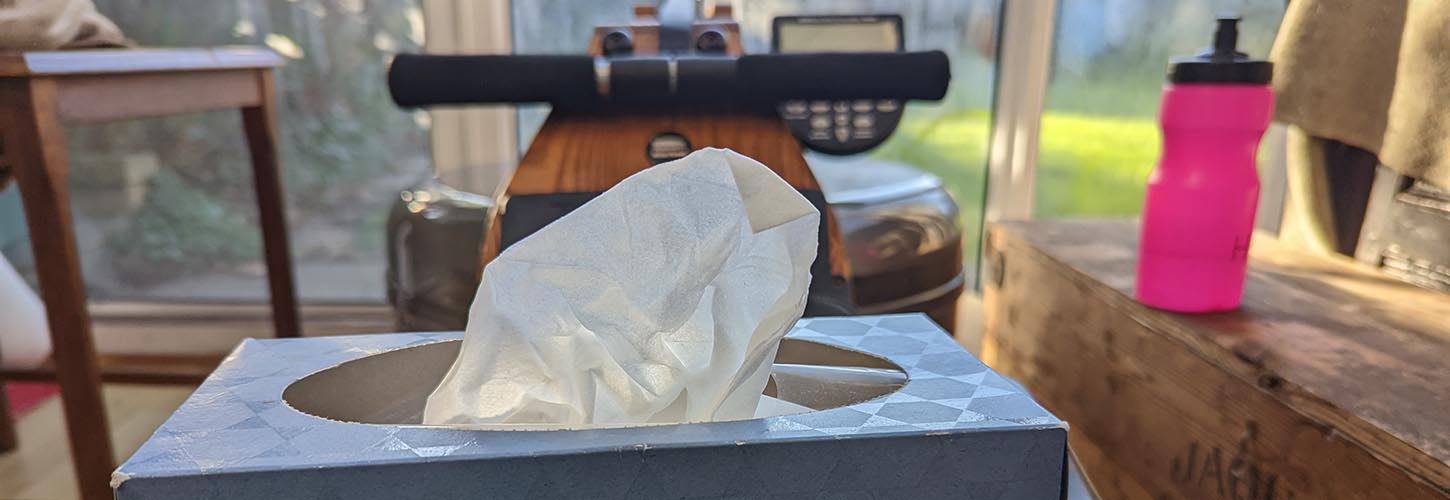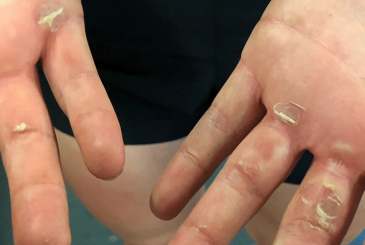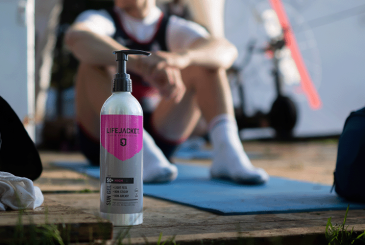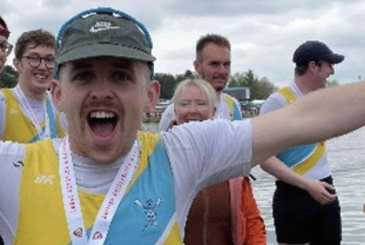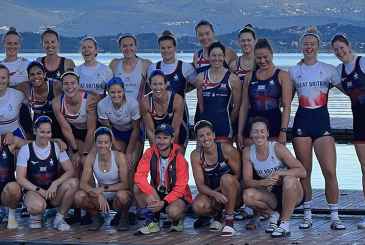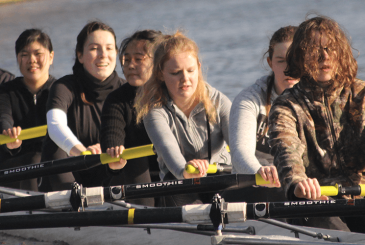Dr Richard Budgett, Paul Davies and Dr Rod Jaques give their professional advice
The average adult experiences between one and six bouts of the common cold each year and it is estimated that at any given time one in sixty adults in the UK will be suffering from a cold infection. Influenza, whilst not as common, still affects an estimated 10-15 % of the population annually. The good news for recreationally active athletes is that their incidences of colds and flu seem to be lower than that of the general population. The bad news for the harder training rowers is that their risk of contracting a winter illness seems to be even greater than that of the population at large.
What is a cold?
The common cold is a viral infection that can be caused by any one of up to 250 strains of virus, the most common group of which is the rhinovirus (rhino referring to the nose). Rhinoviruses are estimated to be responsible for anywhere between a third and one half of all common colds. Typically the rhinovirus will invade the mucus of the nose, where it rapidly reproduces.
It is this reproduction of the virus, and your body’s immune reaction to it, that causes the feelings commonly associated with a cold; including fatigue, sore throat, runny or stuffy nose, sneezing and mildly swollen glands.
For most people the acute symptoms of a cold will last somewhere between four and seven days, although complications such as sinusitis and bronchitis can prolong the illness and make it more unpleasant.
How does a cold differ from flu?
Influenza (or flu) is also a viral infection, however a much more serious and malevolent virus causes it. Whilst the common cold virus targets the nose and the upper part of the respiratory tract, influenza infects the upper and/or lower respiratory passages. The risk of associated complications, such as bacterial pneumonia, are much greater with influenza than with colds, making it a much more worrying condition.
The symptoms of influenza often include headache, fever, muscular pain (myalgia) and weakness. In addition to these, joint pain, sensitivity to light, nausea and vomiting may also be experienced. The major differences between cold and flu are that colds rarely cause a fever or body aches, cold symptoms are more likely to be confined above the neck and are less likely to appear suddenly.
How do we contract a cold or flu?
As cold and flu viruses are commonly transmitted through the eyes, mouth, nose and respiratory passages, they are easily transferred by touch, or by contact with aerosols (airborne particles) that are created by coughing or sneezing.
How to avoid contracting a winter illness
Avoid the virus altogether
Obviously a lack of exposure to the virus will dramatically reduce the chances of contracting an infection, however avoiding the virus is not always that easy. The best method of reducing contact with the virus is giving cold sufferers a wide berth. Research shows that children suffer from more colds per year than adults. This is bad news if you’re a school teacher or if you have to travel on public transport that serves local schools.
Hand washing
Cold viruses are often introduced into the body from the hands and it is easy to pick up viruses by touching contaminated surfaces, or by shaking hands with infected individuals. Regular and thorough hand washing throughout the day will reduce your chances of infection. It is also wise to avoid unnecessary contact between the hands and the nose, eyes and mouth, especially if you have been in an environment where the virus may have been rife.
Immunosuppression
Whilst short duration, moderate intensity exercise seems to have little effect upon the body’s immune system (it may even bolster it) longer, more demanding workouts have been shown to cause a suppression of the immune system that can last several hours after exercise.
This finding has lead several researchers to suggest that there is an open window to infection in the hours that follow prolonged workouts. Others have suggested that when training sessions are performed frequently the immune system may not be given enough time to return back to normal. This means that the open window may be extended over even greater periods of time, making the hard training athlete even more susceptible to the onset of illness. If this is the case then athletes need to be particularly vigilant during periods of long, hard training.
Typical advice given to athletes at risk includes ensuring adequate rest between sessions, tailoring a training programme that does not leave you feeling overtired, and reducing both physiological and psychological stress during the time of year when colds and winter illnesses are most virulent.
Dietary considerations
A poor diet is one of the biggest factors contributing to a badly functioning immune system. The absence of certain identifiable vitamins and minerals, such as those contained within fruit and vegetables, has been linked with immunosuppression. Because of this many studies have investigated the links between various food and vitamin supplements and the immune system. Examples of supplements studied include; glutamine, vitamin C, zinc, dietary fat and dietary carbohydrate. Unfortunately, the results of many of these studies are contradictory, making it almost impossible for solid recommendations to be made.
Of the supplements listed above it would appear that carbohydrate is the one that deserves the greatest attention. There are an increasing number of research studies that show that immunosuppression occurs in response to conditions of low blood glucose and depleted muscle glycogen. Recent studies have shown that maintaining blood glucose levels during exercise, by consuming a carbohydrate drink for example, can reduce or even prevent the immunosuppression often seen after prolonged exercise.
What to do if you pick up an illness
There may be occasions where, despite your best efforts, a virus manages to get a hold in your system. When this happens the first task is to identify whether you are suffering from a cold or from flu, as the recommendations for dealing with each illness will be different.
If the symptoms are localised above the neck and do not include a fever light exercise may actually help to speed recovery. In this situation it is recommended that very low intensity exercise be performed for a period of five to seven days until the symptoms have disappeared. After this time training load can be gradually built up over a period of three days, with full training being resumed on the fourth day if symptoms are completely cleared and recovery is complete. The temptation to resume hard training too early is a dangerous one, as hard exercise performed at this time will increase the likelihood of a secondary infection such as bronchitis or sinusitis.
Presence of symptoms below the neck suggests a more severe and widespread infection. In this instance a medical opinion should be sought and a period of complete rest for between three and seven days is recommended. Following this, if the symptoms have reduced such that aches, fever, fatigue and productive cough are no longer present, light exercise may be performed.
This light exercise should be continued for a period of a further five to seven days, then, if symptoms have completely resolved, a gradual escalation of training up to normal levels can occur. Again, returning to hard training too soon after an illness such flu will leave the body more susceptible to secondary infection and may even result in debilitating Post Viral Fatigue.
If you are unlucky enough to get struck down by a cold or the flu this winter take pity on your colleagues and training companions by putting yourself into quarantine. People are usually at their most infectious at the start of a cold so it may be prudent to hide yourself away at this time. Try not to see your illness as lost time, make the most of it by using your free time to stretch, drink plenty of fluids and more importantly relax. our body will thank you for it in the long run.
For those athletes subject to in and out of competition testing it is important to know that certain banned substances may appear in cough remedies and mixtures, and advice should be sought before taking any new medication or supplement.
Dr Rod Jaques is Medical Officer at the British Olympic Centre and also to the English Institute of Sport in Bath and the British Triathlon Association.
Paul Davies is a BASES Accredited Exercise Physiologist and Lecturer in Exercise Physiology and Sports Nutrition at Edge Hill College, Lancashire. He worked with many of the Nations top sportsmen and women at the British Olympic Medical Centre.
Dr Richard Budgett is Director of Medical Services of the British Olympic Association and Chairman of the ARA Medical Committee. He was Olympic Champion in the coxed four at the 1984 Olympic Games.
This article was previously published in Triathlon magazine.
For more information on British Rowing’s anti-doping policy, click here.


